
Say Something New: 10 Ways to Justify Original Research
By Michele Linn
“I am so tired of having nothing new to say. I feel like we are having the same conversation again and again.” That’s what a fellow marketer (and friend) said to me recently.
As someone who has been in marketing for almost 20 years (ten of those in content marketing), I have felt this way more times than I’d like to admit. I yearned to break free from writing the same posts about the same topics. I wanted to say something new, something different, something meaningful.
There is an opportunity in front of each of us to ease this pain: creating original research.
To quickly level set, original research is any data-driven story you publish. Some examples are:
- State of the industry reports (and other survey-based research findings)
- Short Polls
- Analysis of existing data
- Presenting secondary data in a new way
Data-driven content works well on many levels. When you plan well, you have the opportunity to investigate something you believe to be true (or untrue) – and then use data to test that hypothesis. You get lead a new conversation that combines a compelling story with valid, accurate data.
Hint: You can use this article to help justify a project. Focus on the ideas that are most important to those from whom you need to get buy-in.
B2B buyers think research is influential
We ultimately want to be a useful source of information for our audience. If you are in a B2B space, consider this: according to a survey with CMI and Smartbrief, focusing on how content influences the B2B purchasing process, 74% of those involved in the buying process consider original research to be influential in the buying process. This ranks second only to peer-to-peer recommendations.
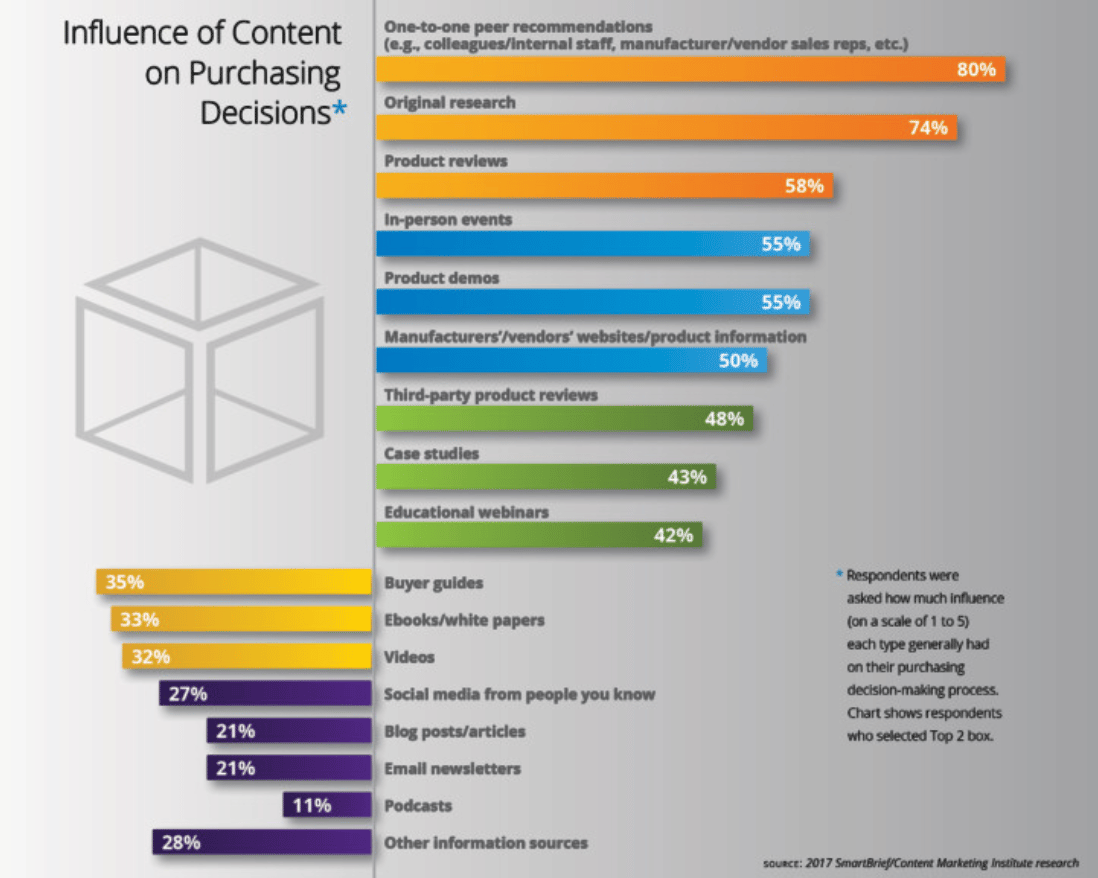
Data-based content is perceived as more trustworthy
It’s not only B2B buyers who are influenced by research. In a survey of more than 1,000 adults in the US, SurveyMonkey learned the following:
- 75% of people say content that contains data is more trustworthy than content without data.
- 82% of people say they prefer to read an article based on data instead of one based on the writer’s opinion.
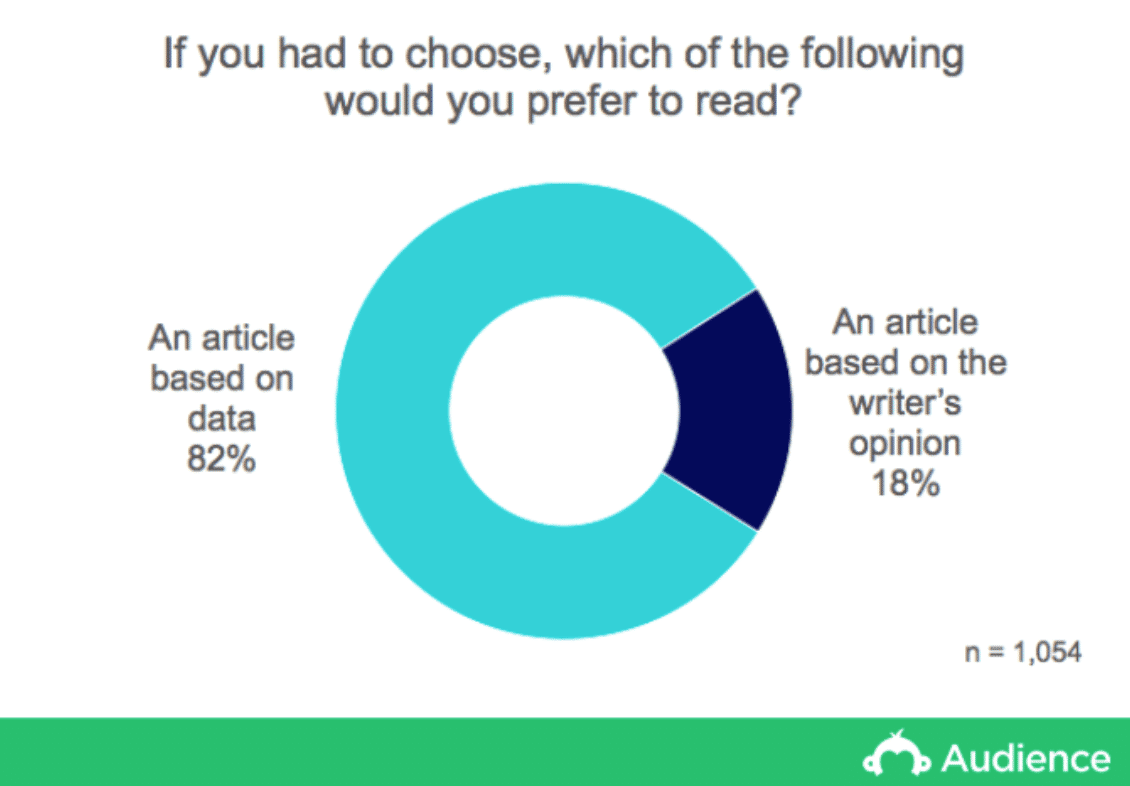
Research is effective at getting backlinks
Because people consider research to be influential and trustworthy, it may come as no surprise that it’s something people share, and perhaps more importantly, link to. Backlinks help a site to rank better, especially if those links come from websites with a high domain authority. Conducting original research is an ideal option for marketers who want to get more backlinks.
For instance, Andy Crestodina, who publishes an annual blogger study (that takes his team 150 hours) has explained:
“[Original research] may take 10x the effort to create, but you’ll likely see 100x the results of a typical article.”
And this is easily seen when you look at the backlinks to his website. When you use Buzzsumo to see which content on Orbit Media’s website has the most backlinks, their annual blogger study tops the list — by far!
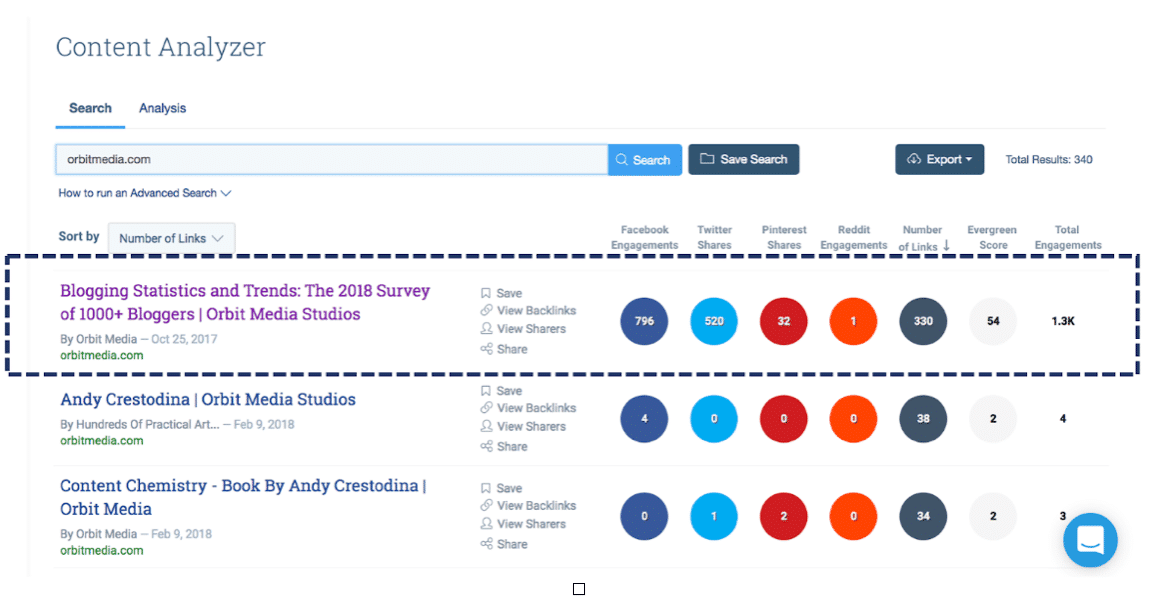
Research from Buzzsumo draws a similar conclusion. Earlier this year, they published their Content Trends report, in which they analyzed 100 million articles from 2017. Not to get too meta, but this research-backed report has their highest number of links for the year.
They found that the average number of social shares per article has been cut in half since 2015 (and 70% of content has zero inbound links). However, there are a couple of bright spots. The author, Steve Rayson also found:
“Authoritative research and reference content are the . . . two types of content consistently getting links and shares.”
Also consider SEO PowerSuite’s Link Building Survey. This survey of 628 SEO professionals found that data/research is the most efficient type of content for link building.
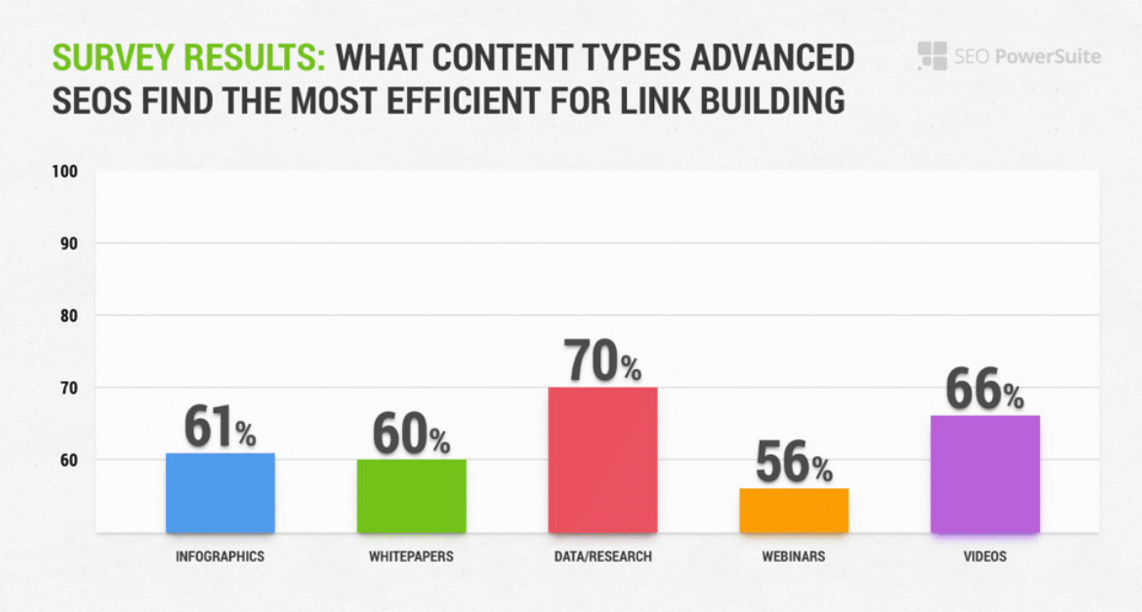
Journalists love research
Media mentions are a special kind of backlink. In fact, it is considered the holy grail of backlinks by many marketers we talk to. While there are no certainties of what the press will cover, research is something many journlists tell me they are actively looking to cover.
Here are three great examples to share with your management if getting more media mentions is one of their goals:
- LendEDU regularly publishes short polls and analyzes secondary data around timely topics. For instance, Investing in Bitcoin: Survey & Report was picked up by CNBC, Forbes and Business Insider. Or take their piece, The Finances of Fortnite: How Much Are People Spending on This Game?, which was covered in Time.
- RentCafe is another great example to study if you’re interested in getting media pickup. By analyzing existing data (such as US Census data), their article, Millennials Spend About $93,000 on Rent by The Time They Hit 30, was covered widely by publications such as the Los Angeles Daily News, CNBC, National Association of Realtors, Time and NY Post. Another great example: Renters Became the Majority Population in 22 Big US Cities was picked up by publications such as the Chicago Tribune, New York Times and Realtor.com.
- Annual surveys can also get wide coverage as well. A great example of this is Edelman Trust Barometer, which has been picked up by media sites such as The Atlantic, HBR and CNN.
As Laura Kane, PRSA’s Chief Communications Officer told me:
“Research that generates unique points of view on an issue is an enduring and effective way to generate conversations with key stakeholders and the media. In fact, it is probably the fastest way to establish oneself as a thought leader. It is easy for journalists to find people who are willing to share an opinion on a subject, it is rarer to find someone who has data points related to that topic. Original research and related data makes you a credible source for reporters and can help you develop a following of interested stakeholders.
Some examples of people who do this successfully are Edelman with their Trust Barometer, Fortune with their Most Admired Companies List and the National Association of Realtors with their many reports on home sales. Each of these lists is not only covered by the media, it is widely anticipated and shared by its core audience.”
Research offers highly visual and shareable content
Another reason research works is it inherently includes shareable and visual content.
As Brian Dean recently explained when he shared his strategies for getting backlinks:
“Here at Backlinko, we’ve done three major research studies . . . And I can tell you from experience that attractive charts and graphs have led to 2-3x more links. That’s because lots of bloggers embed our charts in their content… with a link back to the study.”
Bloggers see better results with research
Bloggers who use research are more likely to see strong results, according to the Orbit media 2018 blogger study.
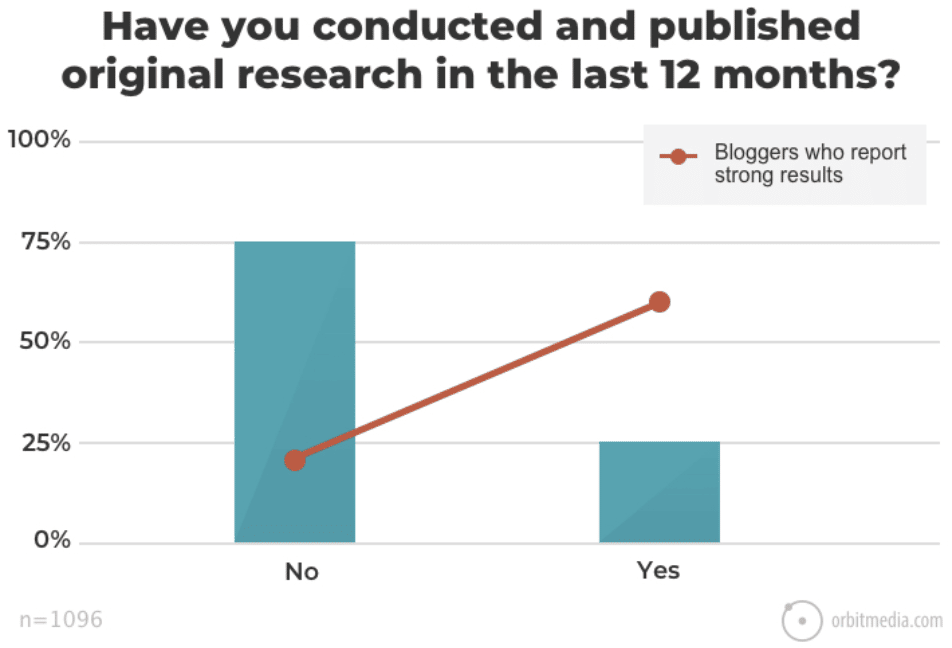
Research leads to leads, subscribers and sales
“This all sounds great,” you may be thinking, “but will research impact our bottom line?”
Of course, your mileage will vary, but I love this example from Andrea Fryrear. Her business, AgileSherpas, is a relatively new company with a specific objective (Agile Marketing training). She’s very educational in her approach and decided to publish the first State of Agile Marketing earlier this year. It’s her first go at a report for her new business, and she has seen backlinks, consistent subscribers and sales. This is a GREAT example of research that works right here, right now for very small businesses.
As Andrea explains:
“Our State of Agile Marketing research has been a virtual gold mine for subscribers, backlinks, and real money-in-the-bank clients. In our CRM I’ll see someone has downloaded the report, and within a couple of days (sometimes a couple of hours!) I’ll see that same someone requesting a call to talk about becoming a client. There’s a clear correlation between reading the report and being ready to make a purchase.”
Research recharges your editorial
Are you looking for a way to tell a more cohesive story for your brand? If so, conducting a large benchmarking study can be a brilliant option. In fact, one survey can fuel a year’s worth of content.
As Margie Agin succinctly conveys:
“Think of original research as “big rock” content you can slice and dice in endless ways to create unique social posts, infographics, event presentations, sales scripts and more.”
Below is a chart of the type of assets you may want to prioritize based on your goals. (Learn why you need to identify your primary goal for your research.)
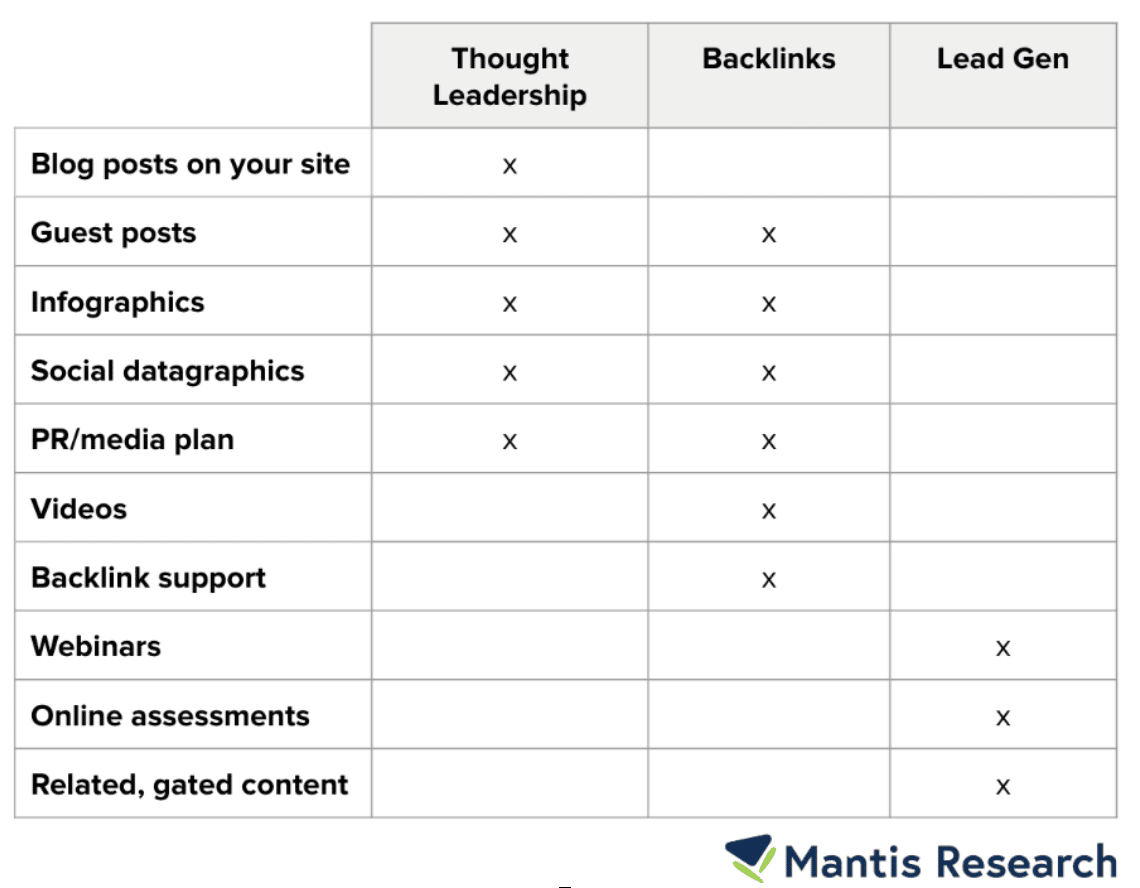
Marketers who conduct research plan to use it again
How common is it for marketers to use original research in their marketing efforts?
Earlier this year, our firm, Mantis Research, surveyed nearly 700 marketers in partnership with Buzzsumo to understand if and how marketers are using original research. We discovered that approximately half of marketers are using research, and of those who aren’t yet using research, half are considering their first project in the coming year.
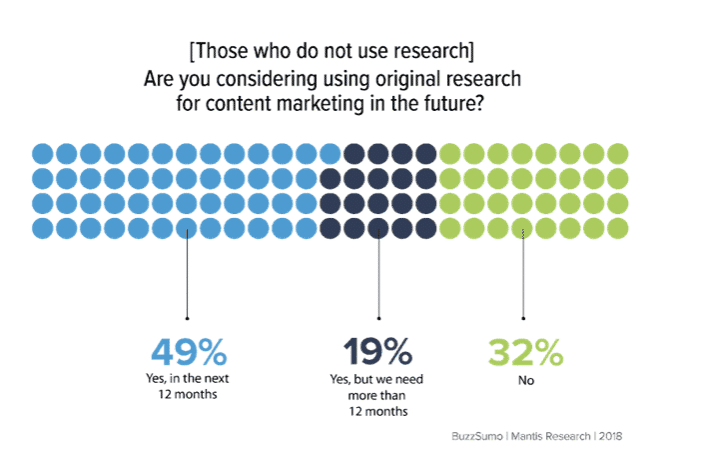
Of those who are currently using research, more than nine out of ten plan to conduct additional research. In short: research works.
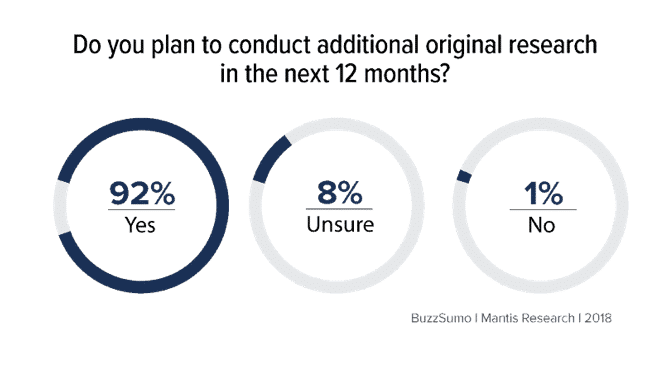
Research gives you authority and credibility, especially if you start now
We are going to end where we began: if you want to lead a conversation that is new and meaningful, consider research so you become the source that people link to and talk about.
If you are struggling to move research from a “nice to have” to a “need to have,” consider that the best research topics:
- Are interesting to your audience
- Align with your brand’s story
- Have not already been covered
Pay close attention to that last point: the best topics are those that have not yet been covered.
If you are in a space and no research currently exists, your moment is absolutely now. That was the situation we found ourselves in, way back in 2010, when we launched Content Marketing Institute. Our founder, Joe Pulizzi, had the foresight to conduct research on the state of the content marketing industry, which has been repeated annually. The research became the backbone of our editorial and had thousands of mentions.
That said, if you are in a crowded space, your moment is also now. Find your niche and own it before someone else does. As Brody Dorland told me when they were creating their first research report last year (which they repeated this past year):
“We did not want to do a state of content marketing report because others had already done so. Instead, we decided to focus specifically on content planning, which is something that had not been covered – and it’s something our business directly helps marketers with. This research was a way for us to better understand the challenges our customers face, validate the direction of our product roadmap, and provide insights that marketers can use to benchmark their own content planning process.”
Where to go from here
As the stories and stats in this article show, original research works. It can immediately impact the bottom line and position your organization as a thought leader in your industry.
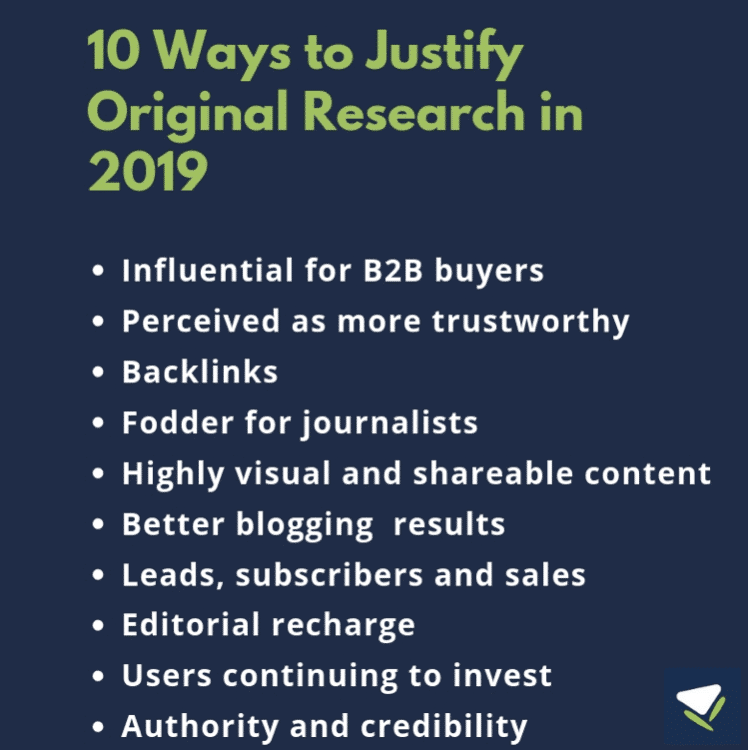
If you’re convinced, where do you go from here?
Share the statistics and quotes from this article with your leadership team. After securing their buy-in, your next step is to determine what your desired outcome is. The answers to this question will help you to determine what topic to cover, what type of research project to do, how to amplify it, whether you should gate it and more. This article goes into more detail on how goals determines the tactics you pursue.
And just like that – you’ll be on your way to saying something new and meaningful again.






